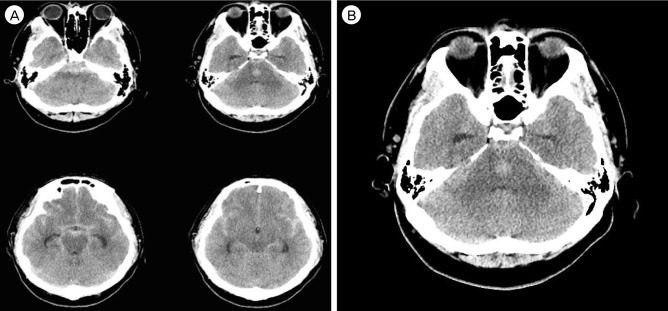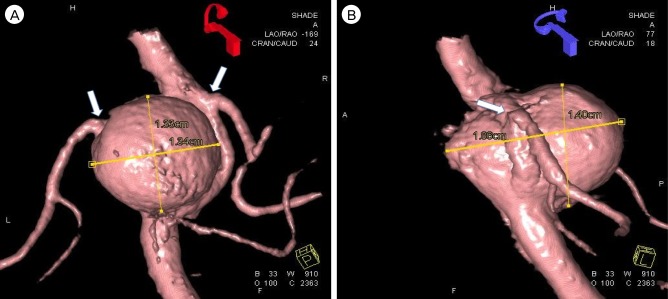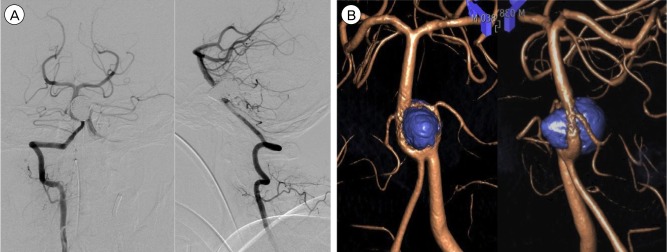Abstract
Basilar artery fenestration is infrequent and even rarer in association with a large aneurysm. With proximity to brain stem and vital perforators, endovascular coiling can be considered first. If the large ruptured aneurysm with a wide neck originated from fenestra of the proximal basilar artery and the fenestration loop has branches of posterior circulation, therapeutic consideration should be thorough and fractionized. We report endovascular therapeutic details for a case of a ruptured large saccular aneurysm in proximal basilar artery fenestration.
Modern advancements of the endovascular coiling procedure for aneurysms have replaced a large portion of aneurysm clipping surgery. Aneurysms originating from the vertebrobasilar junction (VBJ) require a skull base approach and critical dissection around the brain stem. In addition, clipping of large aneurysms associated with fenestration of the proximal basilar artery (BA) is very difficult, and endovascular coiling is the primary treatment option in this type of aneurysm.11)13) Preservation of BA and vital branches such as the anterior inferior cerebellar artery (AICA) or posterior inferior cerebellar artery (PICA) and complete packing of the aneurysm are key points of this procedure. To solve this problem, three dimensional (3D) angiography is extremely beneficial for confirmation of thorough visualization of aneurysm morphology and origin point of branches. If the large aneurysm with wide a neck is ruptured, various technical points including stent deployment and antiplatelet preparation should be considered.
A 38-year-old male patient visited our emergency room with a sudden bursting headache and posterior neck pain. His mentality was alert with no neurologic deficits. Immediate brain computed tomography (CT) scan showed a diffuse Fisher grade 2 subarachnoid hemorrhage (SAH) and unusual round hemorrhagic high density at the medial pons level (Fig. 1). Subsequent CT angiography confirmed a ruptured large saccular aneurysm, occupying the proximal BA fenestration just after VBJ. The median pons was markedly compressed by the aneurysm (Fig. 2). For decision-making, the patient underwent digital subtraction angiography (DSA) through the right femoral artery route. Each vertebral artery angiography confirmed the presence of a large saccular aneurysm originating from the proximal end of fenestration. On 3D rotational DSA to confirm exact 3-dimensional morphology, it was so large that it occupied the whole fenestration circle and measured 14 mm sagittal height, 13.4 mm right-left width, and 18.6mm anterior-posterior width. Both AICA and PICA common trunks originated at each fenestration loop on both sides (Fig. 3).
For safe preservation of both VBJs, we decided to perform stent assist coiling. To prevent rebleeding, Levin tube insertion was performed after induction of general anesthesia and ingestion of crushed clopidogrel (600 mg) was deferred until successful lodging of the following microcatheters into targeting sites. Also, intravenous heparin was not prescribed, rather, heparinized irrigating saline of catheters (5,000 unit/L) was administered instead. Each femoral artery was punctured and a 6 F sheath (Terumo Medical Co., Somerset, NJ, USA) was inserted. The 6F Envoy guiding catheter (Codman & Shurtleff Inc., Raynham, MA, USA) was inserted into the V2 portion of each vertebral artery. To save the AICA-PICA common trunk of each vertebral artery, through each side Envoy catheter, a prowler select plus microcatheter (Codman & Shurtleff Inc.) was inserted into the upper BA via each fenestration loop (Fig. 4A). To overcome the large size of the aneurysm, insertion of multiple microcatheters into the aneurysm was mandatory. A jailing technique was used to maximize the stability of the microcatheter. A 45 degree tip Excelsior microcatheter (Stryker Neurovascular, Fremont, CA, USA) was introduced into the aneurysm center through a right side Envoy guiding catheter, and another right angle tip Excelsior microcatheter was also introduced into the aneurysm center through left side Envoy guiding catheter.
A 14 × 30 mm Target 360 soft coil (Stryker Neurovascular) was partially deployed through a right side Excelsior microcatheter. A 4.5 × 37 mm Enterprise stent (Codman & Shurtleff Inc.) was gently inserted, and deployed successfully from upper BA, via the right side fenestration loop to the right vertebral artery using a Prowler select plus microcatheter, inserted through right side Envoy guiding catheter (Fig. 4B). A 13 × 30 mm Target 360 soft coil was partially deployed via the left side using an Excelsior microcatheter. Then, a 4.5 × 37 mm Enterprise stent was gently inserted using a Prowler select plus microcatheter, inserted through left side Envoy guiding catheter. However, compared to the right side, the left side Enterprise stent was deployed more distally. This location of "from end of left fenestration loop to distal vertebral artery" successfully prohibited unnecessary overlapping of stent struts in BA (Fig. 4C). After confirmation of full patency of the posterior circulation, through the two jailed Excelsior microcatheters, stepwise coil packing was performed sequentially (total length 380 cm). Final angiography confirmed complete packing of aneurysm with coils, excellent patency of both fenestration loops with AICA-PICA common trunks and distal BA (Fig. 5). Diffusion weighted magnetic resonance image (MRI), checked 4 days after treatment, showed small embolic dots at the left cerebellum and splenium of the corpus callosum (Fig. 6). The status of platelet inhibition was checked using the VerifyNow® system (Accriva Diagnostics, San Diego, CA, USA) 7 days after the procedure. The resulting values were the same as follows: P2Y12 Platelet Response Unit (PRU) 258 and inhibition 0%. The dosage of clopidogrel (150 mg/day) was increased and a PRU value of 148 with inhibition of 28% was confirmed. The patient recovered without neurologic deficits.
The BA is the second most common site of intracranial fenestration, after the anterior communicating artery. Embryologically, formation of the BA occurs at around the 5-9 mm fetal stage by fusion of paired longitudinal neural arteries. Failure of this fusion process with a persistent bridging artery may result in fenestration anywhere along the course of the BA, but most often in the proximal portion.6) The medial walls of fenestration have focal defects at both ends. Like an usual aneurysm occurring at the bifurcation point, these focal defects can be an eliciting factor in aneurysm formation.5)
Studies on association between BA fenestration and accompanying aneurysm are somewhat controversial. In a previous report, the reported incidence of association was as high as 35% (21 cases of aneurysm at the fenestration site/59 cases of BA or VBJ fenestration).3) However, modern evaluation of large cases failed to reveal any association (0 case of aneurysm at the fenestration site/215 BA fenestrations)4)10) or very uncommon with incidence of approximately 0.33% of all intracranial aneurysms.11) Some authors have reported that fenestrations are more often detected within the posterior circulation (73.2%) rather than anterior (24.6%), although there was no difference in prevalence of aneurysms.4)
The fenestration of BA can be classified as two types. Kai et al. proposed two types of classification. Type A has a bridging artery between distal V4 portions of both vertebral arteries. The resultant fenestration showed a somewhat triangular shape. Type B does not have a bridging artery and somewhat elliptical fenestration.7) With improvement of 3-dimensional angiographic technology and endovascular technique, Trivelato et al. proposed a new classification based on aneurysm neck size and base of implantation in the proximal bifurcation of fenestration. Four types are the same as follows: 1A: narrow neck, symmetric at the bifurcation. 1B: narrow neck, spars one loop. 2A: wide neck, involves both loops. 2B : wide neck, spares one loop.12) Our case is compatible with Kai type B-Trivelato type 2A. In this type of aneurysm, to save distal basilar and critical perforator flow, stent or balloon assist coiling is mandatory. Preoperative decision is important for this type of aneurysm. Using 3D angiography, the origin of the PICA should be checked with the possibility of sacrifice during the procedure. If the PICA originates from the proximal portion to the fenestration loop, the loop can be sacrificed.1) In our case, the AICA-PICA common trunk originated from each fenestration loop on both sides. Its occurrence rate is 20 to 24%. Saving this common trunk is extremely important. This is because inadvertent injury to this trunk at its origin during surgical or endovascular treatment would result in a major stroke involving the anterior (or petrosal) surface (AICA), as well as the posterior (or suboccipital) surface (PICA) of the cerebellum.2)
Both femoral punctures were performed for separate deployment of the stent occupying each fenestration loop, and to minimize overlying, double stenting at the BA the right side stent was deployed from upper basilar to V4 of the right vertebral artery.
The left side stent was deployed from the upper 12 o'clock portion of the fenestration loop to V4 of the left vertebral artery. In summary, decision making for endovascular coiling of this type of aneurysm is mainly dependent on the relationship between AICA or PICA and the fenestration loop. If the AICA or PICA does not originate from the fenestration loop, one side of the fenestration loop of the vertebral artery could be occluded safely.1)
Another important point is antiplatelet medication for stent insertion. From the experience of coronary stenting, intracranial stenting or stent assist coil embolization of unruptured aneurysms also requires sufficient premedication with an antiplatelet agent, mainly P2Y12 blocker, such as clipodogrel. Before stenting procedures, confident and safe serum level of an ingested drug can be double checked by platelet function assay.9) Some authors reported that intensifying antiplatelet therapy to achieve ≥20% P2Y12 inhibition in a platelet function assay does not result in higher numbers of ischemic or hemorrhagic events, however there is a trend toward more death in the resistant group by 30 and 90 days of those experiencing complications.8) Unlike the unruptured one, in the stent assist coil embolization of ruptured aneurysms there is an innate dilemma regarding "how and when" clopidogrel will be ingested. Thorough evaluation of angiographic anatomy and decision making to deploy a stent should be made preoperatively and a Levin tube was inserted just after induction of anesthesia. The optimal time of ingestion may be after successful lodging of microcatheters for stent delivery and coil delivery impending jailing, just before stent insertion.
In cases of a large aneurysm originating from the fenestration loop of BA, for saving of vital branches of the posterior circulation, stent assist coiling is essential. Unlike unruptured aneurysms, the ruptured one should be performed with special consideration for "the order" of stent and coil insertion as well as antiplatelet medication.
References
1. Albanese E, Russo A, Ulm AJ. Fenestrated vertebrobasilar junction aneurysm: diagnostic and therapeutic considerations. J Neurosurg. 2009; 3. 110(3):525–529. PMID: 19012487.

2. Baskaya MK, Coscarella E, Jea A, Morcos JJ. Aneurysm of the anterior inferior cerebellar artery-posterior inferior cerebellar artery variant: case report with anatomical description in the cadaver. Neurosurgery. 2006; 2. 58(2):E388. discussion E388. PMID: 16462470.

3. Campos J, Fox AJ, Vinuela F, Lylyk P, Ferguson GG, Drake CG, et al. Saccular aneurysms in basilar artery fenestration. AJNR Am J Neuroradiol. 1987; Mar-Apr. 8(2):233–236. PMID: 3105281.
4. Cooke DL, Stout CE, Kim WT, Kansagra AP, Yu JP, Gu A, et al. Cerebral arterial fenestrations. Interv Neuroradiol. 2014; May-Jun. 20(3):261–274. PMID: 24976087.

5. Finlay HM, Canham PB. The layered fabric of cerebral artery fenestrations. Stroke. 1994; 9. 25(9):1799–1806. PMID: 8073460.

6. Giuffrè R, Sherkat S. The vertebral artery: developmental pathology. J Neurosurg Sci. 1999; 9. 43(3):175–189. PMID: 10817385.
7. Kai Y, Hamada J, Morioka M, Yano S, Fujioka S, Kuratsu J. Endovascular treatment of ruptured aneurysms associated with fenestrated basilar artery. Two case reports. Neurol Med Chir (Tokyo). 2006; 5. 46(5):244–247. PMID: 16723817.
8. Nordeen JD, Patel AV, Darracott RM, Johns GS, Taussky P, Tawk RG, et al. Clopidogrel Resistance by P2Y12 Platelet Function Testing in Patients Undergoing Neuroendovascular Procedures: Incidence of Ischemic and Hemorrhagic Complications. J Vasc Interv Neurol. 2013; 6. 6(1):26–34. PMID: 23826440.
9. Prabhakaran S, Wells KR, Lee VH, Flaherty CA, Lopes DK. Prevalence and risk factors for aspirin and clopidogrel resistance in cerebrovascular stenting. AJNR Am J Neuroradiol. 2008; 2. 29(2):281–285. PMID: 17989373.

10. Sogawa K, Kikuchi Y, O'Uchi T, Tanaka M, Inoue T. Fenestrations of the basilar artery demonstrated on magnetic resonance angiograms: an analysis of 212 cases. Interv Neuroradiol. 2013; 12. 19(4):461–465. PMID: 24355150.

11. Tanaka S, Tokimura H, Makiuchi T, Nagayama T, Takasaki K, Tomosugi T, et al. Clinical presentation and treatment of aneurysms associated with basilar artery fenestration. J Clin Neurosci. 2012; 3. 19(3):394–401. PMID: 22285479.

12. Trivelato FP, Abud DG, Nakiri GS, de Castro Afonso LH, Ulhoa AC, Manzato LB, et al. Basilar Artery Fenestration Aneurysms: Endovascular Treatment Strategies Based on 3D Morphology. Clin Neuroradiol. DOI: 10.1007/s00062-014-0336-0.

13. Yoon SM, Chun YI, Kwon Y, Kwun BD. Vertebrobasilar junction aneurysms associated with fenestration: experience of five cases treated with Guglielmi detachable coils. Surg Neurol. 2004; 3. 61(3):248–254. PMID: 14984996.

Fig. 1
(A) Initial non-enhanced brain CT shows diffuse subarachnoid hemorrhage. (B) At low median pons level, thin round hemorrhagic high density is definite.

Fig. 2
(A) Initial CT angiography confirms "teardrop" shaped large saccular aneurysm penetrate and fill the fenestration loop at low basilar artery, just distal to vertebrobasilar junction. (B) Lateral view shows daughter sac at the anterior-upper side of aneurysm, which elicited subarachnoid hemorrhage rather than intracerebral hemorrhage into pons.

Fig. 3
The anterior-posterior (A) and lateral (B) view of 3-dimensional (3D) angiography confirms large ruptured aneurysm at fenestration loop of distal basilar artery (13.4 × 14 × 18.6 mm). The both AICA-PICA common trunks are originated from each fenestration.

Fig. 4
(A) The roadmap view during endovascular procedure shows successful launching of Prowler select plus microcatheters into upper basilar artery by way of each fenestration loop (right side, arrows & left side, arrow heads). (B) The right VA angiography shows successful deploy of Enterprise stent from basilar artery, by way of right fenestration loop, to vertebral artery (arrows). (C) The left VA angiography shows tips of Enterprise stents (right side, arrows & left side, arrow heads).





 PDF
PDF ePub
ePub Citation
Citation Print
Print




 XML Download
XML Download